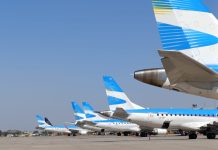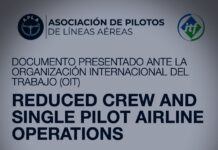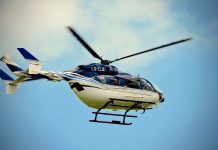Home
Secretarías
Secretaría de Seguridad Second Workshop/Meeting of the SAM Implementation Group Regional Project RLA/06/901 (SAM/IG/2)
Second Workshop/Meeting of the SAM Implementation Group Regional Project RLA/06/901 (SAM/IG/2)
Second Workshop/Meeting of the SAM Implementation Group Regional Project RLA/06/901 (SAM/IG/2)
ICAO Regional Office, Lima, Peru, 3 – 7 November 2008
RAPPORTEUR F/O DARIO MARCOPPIDO (APLA –ARGENTINA)
EXECUTIVE SUMMARY
This Workshop/Meeting has the aim to continue the implementation activities of ATM components and the corresponding support of communications, navigation and surveillance system.
In order to comply with this objective, action plans for the optimization of the ATS routes network, performance-based navigation (PBN) and air traffic flow management (ATFM) implementation shall be reviewed. Regarding performance navigation, the tasks to be particularly developed for aircraft approval in the fields of operations and airworthiness, will be reviewed, same which are of utmost importance for the implementation of the action plan.
It is also expected to continue with the revision of the action plans for the improvement in the situational awareness and data communications between facilities that will be executed through the implementation of improvement of communications and surveillance capabilities for en-route and terminal area operations.
1. GENERAL INFORMATION
1.1 The meeting was attended by 34 participants of Argentina, Bolivia, Brazil, Chile, Ecuador, United States, México, Paraguay, Perú, Uruguay y Venezuela, and organizations like ARINC, IATA, IFALPA. There were also representatives from LAN Airlines.
1.2 The Meeting agreed to hold its sessions from 09:00 to 15:00 hours, with appropriate breaks. The work was done with the Meeting as a Single Committee, Working Groups and Ad-hoc Groups. Mr. Rafael Sánchez Greiner, delegate from Venezuela, served as Chairman of the Meeting and Mr. Paulo Vila Millones, delegate from DGAC Peru, as Vice President.
1.3 Agenda:
– Agenda Item 1: Optimization of the ATS routes structure
– Agenda Item 2: Implementation of performance-based navigation (PBN) in the SAM Region
– Agenda Item 3: Standards and procedures for performance-based navigation operations approval
– Agenda Item 4: Implementation of air traffic flow management (ATFM) in the SAM Region
– Agenda Item 5: Assessment of operational requirements in order to determine the implementation of communications and surveillance (CNS) capabilities improvement for en-route and terminal area operations
– Agenda Item 6: Operational implementation of new ATM automated systems and Integration of the existing systems
– Agenda Item 7: Impact on ACC´s due to multiple reception of the same flight plan
– Agenda Item 8: Other Business
2. REPORT
2.1 Agenda Item 1: Optimization of the ATS routes structure
2.1.1 The SAM/IG/01 Meeting recognized the need for States to make sure that their respective national RNAV route implementation programs is compatible with the SAM RNAV implementation program. It also agreed to continue reviewing, implementing, modifying, or eliminating routes in the SAM Region to optimize the ATS route structure. In this regard, a series of RNAV routes were assessed for implementation.
This representative showed his concerns about the actual status of the navaids which will be the backbone of these new RNAV routes, and also the availability and distance between them. Besides Chile and Brazil, the rest of SAM Region has a separation between navaids of around 150 Nm and located in a way that it would be impossible to triangulate signals to establish accurate aircraft position, based on DME-DMR VOR-DME updates.
2.2 Agenda Item 2: Implementation of performance-based navigation (PBN) in the SAM Region
2.2.1 For evaluation of future airspaces, all relevant data was taken from CARSAMMA database. These data allowed studies and samplings of traffic flows between FL280 and FL410, but most TMA´s were excluded because transit aircraft didnt reach those FL inside its boundaries. Is to mention that CARSAMMA database is based in good predisposition of participant countries, so if a country omit to inform a LHD or another kind of success, the results of this database is fake or incomplete.
In other way, Mrs. Nancy Graham, Director of Air Navigation Bureau (D/ANB) of International Civil Aviation Organization, showed the interrelation between PBN initiatives in other parts of the world, like NEXTGEN and SESAR. This representative, in close talk with Mrs. Graham, exposed the concerns about degradation of CNS systems in SAM region, which posed a high threat to Operational Security. A new CNS system is trying to be fully operational in 2011, when most states cant suitable handle technology that is 20 to 30 years old. A solid CNS system is the main pillar of any future navigation system to be adopted. We need to be fully alert because pre-operational phase of this system is November 2010, with final implantation in November 2011. Just to remember the worst accident in South America, a midair collision between a B737 of Gol Linnas Aereas and an EMB-600 Executive over Amazonica FIR; caused, among others, by a deficient Brazilian ATS structure and system.
Also, it was discussed a method to know the actual avionic capability. The operational approval process has in mind airlines and airliners, and special operations in RNAV 1, RNP 10, and RNP AR APCH environment.
Again, this representative exposed his doubts about capability of aircrafts flying in the region, because most aircrafts are from the 70´s – 80´s (B737 Original, DC9, B727), which CAN´T comply with future regulations and has obsolete and outdated avionics. And we cannot forget the status of General Aviation aircrafts.
In this regard, the Meeting approved the proposal to carry out a survey in all States of the SAM Regional, for identify each aircraft by its Registry versus its PBN capacity. IATA proposed a survey between airlines but will not cover all areas. Most airlines in SAM are not part of IATA.
One more time, I showed my concerns about the actual status of navaids which will be the backbone of these new RNAV routes. The Meeting arrives to the conclusion that a strategy should be discussed to evaluate the VOR and DME coverage, which will handle new RNAV-5 navigation routes. In case that RNAV-5 couldnt be supported by ground based navaids, GNSS and INS could be used, being limited the INS to 2 hours without an updated (In my opinion the last note should be left to operators discretion, because hardware specs may vary between fleets.).
Another topic was SUA´s flexibility, because most PBN routes could be seen seriously affected by these airspaces. In this regard, the Meeting was of the opinion that Air Navigation Service Providers (ANSP) must establish a coordination mechanism with their States military authorities in order to discuss issues such as location, altitudes and validity periods of specific SUA.
2.3 Agenda Item 3: Standards and procedures for performance-based navigation operations approval
2.3.1 The workshop studied regulations to be implanted during PBN transition. Specifically, the ones from FAA (NEXTGEN) and Eurocontrol (SESAR) are going to be studied. Before RNAV-5 operations are authorized, states must include in their respective regulations, specific circulars regarding approval of aircrafts and operators. Taking into consideration that PBN implantation in short and medium term requires development of orientation guidelines, a PBN Roadmap for helping SAM states was written. In order to facilitate this task, the States of ICAO South American Region decide to use as an acceptable compliance source the Advisory Circular AC 91-002 AIRCRAFT AND OPERATORS APPROVAL FOR RNAV 5 OPERATIONS, presented in Appendices A and B (Final Report of SAM/IG/2 in IFALPA intranet), respectively, to this part of the Report and publish respective national regulations up to April 2009.
2.4 Agenda Item 4: Implementation of air traffic flow management (ATFM) in the SAM Region
2.4.1 An ATFM Questionnaire to be completed by States and International Organizations was written, but Meeting took note that to date only four SAM States had replied to the ATFM Questionnaire, and was of the opinion that the administrations that had not yet done so, should complete the Questionnaire and send it electronically to the ICAO South American Regional Office by 30 November 2008. Also a Draft ATFM Roadmap and a Draft ATFM Procedural Handbook were developed, the latter document related with the Roadmap. Brazil and United States offered the States of the Region the possibility of visiting their ATFM units, in order to obtain the experience and information to be used in the implementation of regional and national ATFM
Brazil presented the methodology for the calculation of ATC sectors capacity and of runway capacity. In addition, Argentina presented the result of the runway capacity calculation carried out in Jorge Newbery Airport
2.5 Agenda Item 5: Assessment of operational requirements in order to determine the implementation of communications and surveillance (CNS) capabilities improvement for en-route and terminal area operations
2.5.1 The Meeting reviewed the Guideline for the Improvement of Communications, Navigation and Surveillance Systems for Satisfying Operational Requirement in the Short- and Medium-Term for En-Route and Terminal Area Operations. This guideline presents an analysis and diagnosis of the current CNS systems situation in the Region, identifies operational requirements for en-route operations and terminal area for a short- and medium-term, and proposes the necessary improvements in the CNS systems in order to support en-route terminal and aerodromes operations in the short- and medium-term. The Meeting considered that this document should be reviewed by States of the Region and, in this respect, considered that the ICAO Regional Office circulate said guide to all States participating in the Meeting. Once the document is reviewed, it could be used by States as guidance material for CNS systems improvement in the short- and medium-term, in order to meet operational requirements for en-route operations and terminal area.
Also ARINC made a live presentation of ADS-B system of aircraft flying in the LIMA TMA. As a consequence of this presentation, a roadmap was established for implantation of ADS-B trials in the region.
According to CNS issues shown during the day, this representative showed again the IFALPA concerns about degradation of CNS systems in SAM region, and the lack of speed of the states in reverting this situation. One more time the midair collision between a B737 of Gol Linnas Aereas and an EMB-600 Executive over Amazonica FIR; caused, among others, by a deficient Brazilian ATS structure and system, was remembered.
2.6 Agenda Item 6: Operational implementation of new ATM automated systems and Integration of the existing systems
2.6.1 With the aim of complying with the activities in the action plan for the regional interconnection of automated systems, studies were presented; being the most important (in terms of results and future expansion) the one presented by Argentina, which has an interconnection between Ezeiza and Cordoba ACC´s. The Meeting established that this country should make a guideline to be used by other states involved in the process of interconnection of their respective ACC´s. Argentina and Uruguay actually has a connection (prototype) between EZEIZA and MONTEVIDEO, and was discussed the inclusion of Brazil (Curitiba Center) into this loop.
In the north part of the SAM region, the Maiquetia and Amazonica FIR´s are working together to interconnect both FIR´s.
2.7 Agenda Item 7: Impact on ACC´s due to multiple reception of the same flight plan
2.7.1 The GREPECAS/15 (Río de Janeiro 13-17 October 2008) Meeting concluded that each one of the States affected should solve the problem individually, taking in consideration specific requirements and according to their own necessities (being for outdated o bad implementation of ATS systems). In past meetings, some measures were given in order to mitigate this problem that only creates greater workload to ACC´s and huge waste of money to operators.
The Meeting considered that it would be of great help that the ICAO Regional Office develops an assessment with the purpose to identify those States that at present may be affected by this problem or that already have been affected in some way, and in that case, identify the measures adopted by the State referred, in order to confirm its application by other States of the Region.
2.8 Agenda Item 8: Other Business
2.8.1 The Meeting took note of a proposal to incorporate in Project RLA/06/901 the task of developing an ATM SAM Region Plan in harmony with ICAO Global Plan initiatives, useful for States as guidance for the development of new systems implementation plans. The Meeting considered that there were other short term priorities, but at the same time understood that this task should be maintained in the Regions agenda due to its importance.
Also IATA/Jeppesen presented the meeting with an IP that highlighted the importance for users that states publish their aeronautical information in accordance with the established AIRAC dates.
3 CONCLUSION
Meetings will continue with the final goal of PBN implantation in the region. Next Workshop will be SAM/IG/3, 20 to 24 April 2009, Lima, Peru.
IFALPA ACTIONS
1 IFALPA must continue participating in all ICAO meetings which is invited
2 IFALPA expressed big concerns about the status of CNS systems in the SAM Region, which is not privative of this area but from all regions with developing countries. Also expressed lack of speed and compromise of states regarding immediately resolution of specific problems which affect seriously the Operational Safety. IATA expressed that it would like to see some sort of information exchange with IFALPA, in order to propose resolutions in the short term.
3 IFALPA must continue watching and taking care about the implantation process of new navigation and regulation systems, with the final goal of PBN implantation worldwide.
4 IFALPA must continue surveying the CNS systems worldwide, using their associates with filling the DF9 report, and Annex 19 completed by Regional VP´s.
















